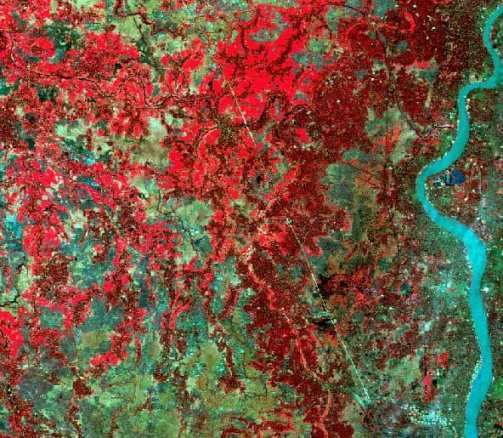Thematic Mapper Sensor
Table of Contents
What is Thematic Mapper?
The Thematic Mapper (TM) is an advanced multispectral scanning, Earth resources Sensor. Its designed to achieve higher image Resolution, sharper spectral separation, improved geometric fidelity and greater radiometric accuracy and resolution than the MSS Sensor.
TM sensor records reflected and emitted electromagnetic energy from the visible, reflective-infrared, middle-infrared, and thermal-infrared regions of the spectrum.
TM had a swath width of approximately 185 km from a height of approximately 705 km. It is useful for vegetation type and health determination, soil moisture, snow and cloud differentiation, rock type discrimination.
TM Resolution
Spatial Resolution of TM is 28.5 × 28.5 m for all bands except the thermal (band 6), which has a spatial resolution of 120 × 120 m. The larger pixel size of this band is necessary for adequate signal strength. However, the thermal band is resampled to 28.5 × 28.5 m to match the other bands. Radiometric Resolution is 8-bit. That each pixel has a possible range of data values from 0 to 255.
TM Bands
Detectors recorded EMR in 7 bands:
- Bands 1, 2, and 3 are in the visible portion of the spectrum and are useful in detecting cultural features such as roads. These bands also show detail in water.
- Bands 4, 5, and 7 are in the reflective-infrared portion of the spectrum and can be used to differentiate between land and water.
- Band 6 is in the thermal portion of the spectrum and is used for thermal mapping.
| Bands | Wavelength (µm) | Resolution (m) | Uses |
|---|---|---|---|
| 1-Blue | 0.45-0.52 | 30 | Coastal water area mapping. Differentiate between soil and vegetation. Forest type mapping. Detect cultural features. |
| 2-Green | 0.52-0.60 | 30 | Green reflectance of healthy vegetation. Identify cultural features. |
| 3-Red | 0.63-0.69 | 30 | Determine soil boundary and geological boundaries. Differentiate between many plant species. Identify cultural features. |
| 4-NIR | 0.76-0.90 | 30 | Determine amount of vegetation biomass. Identify crops. Determine soil and crop boundaries. Determine land and water boundaries. |
| 5-MIR | 1.55-1.75 | 30 | Measure moisture content in plants for crop drought studies and plant health analyses. Differentiate between clouds, snow, and ice. |
| 6-TIR | 10.41-12.5 | 120 | Detect stress in vegetation and crops. Measure heat intensity. Determine insecticide applications. Locate thermal pollution. Locate geothermal activity. |
| 7-MIR | 2.08-2.35 | 30 | Determine boundaries of geologic rock type and soil. Measure soil and vegetation moisture content. |
TM Band Specifications
- Sensor type: opto-mechanical
- Spatial Resolution: 30 m (120 m – thermal)
- Spectral Range: 0.45 – 12.5 µm
- Number of Bands: 7
- Temporal Resolution: 16 days
- Image Size: 185 km X 172 km
- Swath: 185 km
- Programmable: yes
Landsat TM
Thematic Mapper (TM) 30-meter multispectral data from Landsats 4 and 5.
The Landsat TM sensor was carried onboard Landsats 4 and 5 from July 1982 to May 2012 with a 16-day repeat cycle, referenced to the Worldwide Reference System-2.

Landsat TM Data Parameters
| Band number | Band name | Wavelength (μm) | Resolution (m) | Band Applications |
|---|---|---|---|---|
| 1 | Visible Blue | 0.45 – 0.52 | 30 | Bathymetric mapping, distinguishing soil from vegetation, and deciduous from coniferous vegetation |
Landsat TM Band Specifications
| Product Type | Level-1 Corrected |
|---|---|
| Pixel Size | 30-meters |
| Output Format | GeoTIFF |
| Resampling method | Cubic Convolution (CC) |
| Map Projection | UTM – WGS 84 Polar Stereographic for the continent of Antarctica. |
| Image Orientation | Map (North Up) |
